Home > Stories of 2003 > Wren`s "Gotcha" Story
Wren`s "Gotcha" Story
Note: this is a copy of the web page that Deanna originally wrote soon after we got Wren, our first greyhound:
I'm not quite sure what caused us to look at adopting a greyhound- I really had no idea that was an option, nor really gave any thought to the fact that these dogs race, and then what happens when they're done racing. We knew we wanted a dog, but we're both allergic, particularly my husband, even though we both had dogs while growing up. I really didn't want a poodle even though those are supposed to be good for people with allergies. I started looking at pictures on the Howard County Animal Shelter website since I thought it would be good to adopt an unwanted dog. Then somehow, I came across a greyhound rescue site and started doing some research. These dogs, for the most part, are bred to race, although you can find greyhounds that have never raced, and were never meant to race.
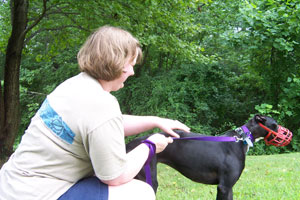
As soon as they don't do well at the track, meaning they aren't making enough money for the owner, they are retired. This can be any time between 2 and 5 years of age. If they did well at racing, they could be kept for breeding purposes. Otherwise, if they are not adopted, they are usually put to sleep, not always in the most humane manner. As pets after retirement, they are very laid back, spending most of the day sleeping (on the couch or bed if they are allowed!). They do need a little bit of exercise each day, and can eventually become a walking or jogging partner after they get their endurance (they were sprinters, not marathoners). Most of them become quite affectionate and happy to meet people- they are not guard dogs, except in the sense that they are big, muscular dogs and so can look a bit frightening. They rarely ever bark, even when barked at. And it was reported that most people with allergies are not allergic to greyhounds since they have such fine, short coats. That pretty much sealed the deal for us, after attending a Meet and Greet at a Petco.
Some other considerations about greyhound ownership is the fact they can never be trusted off-leash unless in a completely fenced area, and the fences have to be at least 6 feet tall. (Some owners report success with lower fences, but they are always supervised in that case.) If they see something they want to chase (and they can see up to a half mile away), they will take off after it, since at their speed (35-45 mph), they could easily catch it, but they are so intent on their prey that they could go through the middle of traffic and be killed. Very likely, once they start the chase, they will not respond to any commands from the owner. Also, because of their shape, they need a special collar, called a martingale collar. Their heads are skinnier than their necks, so if a normal collar is used, they could easily slip their collar and be off-leash and gone.
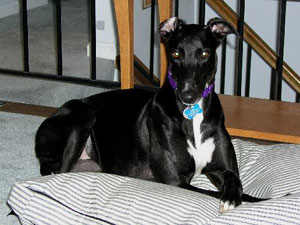
My husband and I started the adoption process with Greyhound Pets of America (MD chapter) back in April 2003 during spring break, but since I was still working on my master's degree, taking the It's Academic team to Myrtle Beach over Memorial Day weekend, and then taking a week-long Alaskan cruise after school ended, we decided to not actually bring a dog home until after our return from Alaska July 5. Unfortunately, while they had a dog picked out for us at that point (Say Hey Wren Nay) there was a problem with the hauler from Florida that month, so we weren't able to adopt until August 9, 2003.
We had been told the hauler would be arriving near Timonium at about 9 am. However, we got a phone call from our adoption representative at about 8 am, telling us the truck pulling the hauler had broken down just north of the Florida border, and so the hauler had to wait until another truck could be sent up from southern Florida- delaying the arrival by about 6 hours, and also changing the location of the dropoff.
We waited at the Maryland House rest stop on I-95 north of Baltimore for about 45 minutes, maybe longer, for the hauler to arrive. When we arrived, we paid for the adoption costs (vaccines, spaying, transportation, food, etc., but what we paid was only about half of the actual cost of rescuing the dog), filled out some paperwork, and picked out a collar and leash for Wren. We knew she was going to be black, and we thought purple would look nice on black, so that's what we chose.
The hauler finally arrived to a great burst of applause and excitement. I had tears in my eyes because the wait was finally over, we were going to meet our girl.
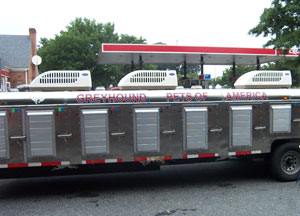
This is just part of the hauler for the dogs. There are 11 "crate" doors on each side. Each space holds two dogs, so this hauler can transport up to 44 dogs at a time. Notice the air conditioners on top- there were four total, with two big generators on the front part of the hauler roof providing power to them.
Wren was one of the last dogs off the hauler. Talk about organized chaos! The dogs were so excited to be out- they were really a handful. They had been on the hauler for over 24 hours. The dogs were snagged by their plastic "normal" collar as the doors were opened. The handler then read the name off the collar and the local representative called out the owner's name. The owner went over to the dog, with leash already attached to the martingale collar and also to themselves. The muzzle was removed, the collar slipped on and adjusted, the muzzle was put back on, and the owner went for an involuntary walk!
Wren walked everywhere, dragging me along. I remember thinking, "Jeez, they're not supposed to be leash-pullers." We walked for about 45 minutes, trying to get her used to us, and more importantly, trying to get her to go to the bathroom before she got in the car for a 45-minute ride. She never did- we were one of the last adopters there- and we decided to head home and take our chances.
I gave Wren a squeaky stuffie toy when we got home. She enjoyed playing with it- tossing it up in the air and biting it to make it squeak. She eventually lay down on her doggie bed, but she still hadn't peed.
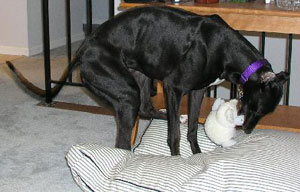
We put her in her crate in our bedroom for the night. I really wasn't sleeping well with the extra unusual dog noises, but she finally made enough noise around 3:30 am to convince me that she had to go to the bathroom. We took her out and finally had success!
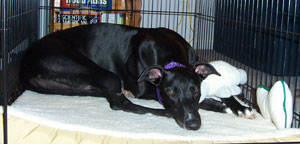
Relaxing in her crate with her stuffie. She sleeps in her crate in the living room area now. We had her sleeping in our bedroom a few nights without the crate, but after a few nights, she was sleeping on the floor next to me, somehow rolled under the bed, then woke up in a panic. She was banging around and shrieking under the bed. We pulled out my wedding dress box and out she popped. Luckily, her only injury was a torn toenail, but she refuses to sleep in the bedroom now, despite the fact she can't let me out of her sight otherwise.